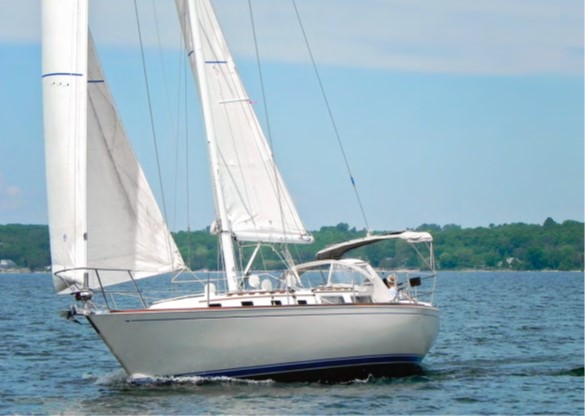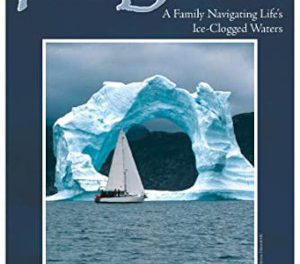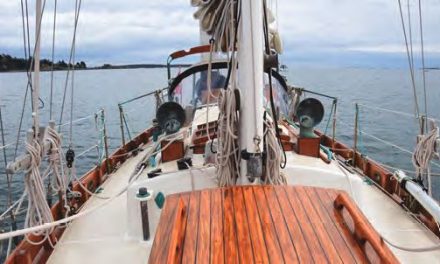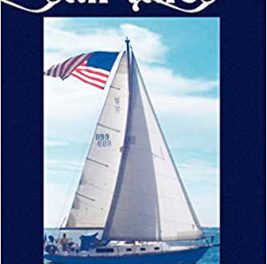A Maine-Built Sailing Master
Issue 141: Nov/Dec 2021
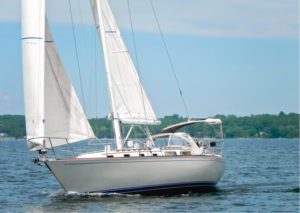
Styling of the Sabre 38, like others in the model line, updates stodgy ’70s design elements with a slightly curvy sheer, raked bow and transom, and low-profile (albeit slightly stepped) coachroof.
When Dave and Sharon Nehring of Racine, Wisconsin, began searching for a boat to serve largely as a comfy floating summer home as well as for cruising Lake Michigan and Green Bay, they happily settled on the classy Sabre 38, which they keep in Sturgeon Bay. Seventh Heaven is the seventh boat they’ve owned, hence the name.
Dave, a retired stockbroker, and Sharon, a retired math teacher, met in high school, became a couple, and attended college together at the University of Wisconsin-Oshkosh, where they started sailing on a friend’s leaky Penguin. Hooked on sailing, they soon owned a 17-foot O’Day daysailer, sailing it on Lake Winnebago. Over the years, five other boats came and went, including a Cape Dory 25, Pearson Vanguard, Yankee 26, Tartan 34, Ericson 35, and finally the Sabre 38 that they acquired in 2014.
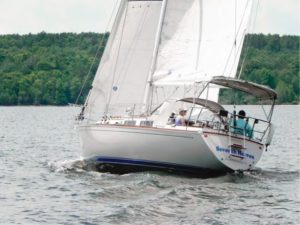
With a good turn of speed, the Sabre 38 is known as a comfortable, well-built boat for cruisers and club racers.
Seventh Heaven is a centerboard, shoal-draft version of the first 100 Sabre 38s built. The production run was 1981 to 1987. The slightly larger and somewhat different Sabre 38 Mk II, also designed by Roger Hewson, was introduced in 1988. Some people refer to the first 38 as a Mk I.
History
Although Canadian Roger Hewson started building 26-foot scows (called Sabre) as a sideline business, in 1970 he and his wife moved to Raymond, Maine, and founded Sabre Yachts with a boat of his own design, the Sabre 28. More than 2,500 boats have been built to the tagline: “Crafted in the Maine Tradition.”
In 1994, Sabre Yachts acquired toolmaker North End Marine of Rockland, Maine. While diversifying into non-marine fiberglass construction, North End Marine was renamed North End Composites and continues to make molds for Sabre, however these are the large, Down East-style powerboats that now carry the name. Sabre ended sailboat production in 2013.
That “Maine Tradition” means quality construction and attention to detail. People look to Sabre for a handsome, solid-quality yacht that is comfortable for cruising and quick around the cans for those who like to race. Sabre built nine different lengths of sailboats 28 to 45 feet and 20 different models. Although the company is no longer building sailboats, Glen Chaplin, director of customer service, says Sabre likes to keep in touch with its sailboat owners and can offer some support, including manuals for rigging and other systems as well as sources for certain parts.
Construction and Mechanicals
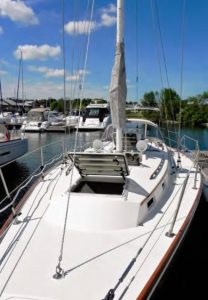
The deck is relatively clean; note the inboard location of the shrouds to allow easy passage fore and aft on the sidedecks and to allow tighter headsail sheeting angles.
Sabre has a reputation for above-average build quality that is evident in the boat’s fiberglass and wood joinery finish work. The hand-laid hull combines polyester resin with alternate plies of 24-ounce woven roving, unidirectional, and 1.5-ounce mat with end-grain balsa wood for coring. Decks were balsa cored with cut-outs where hardware was attached; in those areas, composite or plywood inserts better withstand and distribute compression loads.
The hull-to-deck joint is through-bolted and chemically bonded. The stick-built interior features bulkheads tabbed to the hull, generally regarded as superior to molded fiberglass pans, to form bunk platforms and other interior features. Ballast is external lead secured with stainless steel bolts. Most Sabre rudders were constructed as two half shells, glassed together, and filled with expanding urethane foam.
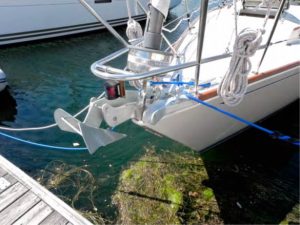
There’s a lot going on at the bow of Seventh Heaven: a two-rail bow pulpit, a large anchor roller as well as a smaller guide for a second anchor, nav light, and Harken furler.
Seventh Heaven’s engine is an old 4-cylinder Westerbeke 33. At the time of purchase, Dave had the motor surveyed separately from the hull and ended up with $5,000 in fixes. But this has been money well spent, as the engine has been very reliable. While the Westerbeke can run at 3,800 rpm, Dave typically sets it for cruise at 2,200 rpm. This yields a smooth under-power speed of about 6 knots.
Conveniently, Seventh Heaven has an electric pump to remove used engine oil during an oil change. This system completely and easily evacuates the oil sump and sends the fluid to a waiting receptacle. It makes it dead easy for an owner to do regular oil changes, encouraging good engine maintenance.
There are also maintenance advantages to the offset prop shaft, one of the boat’s interesting features below the waterline. It’s easy to remove the shaft, if need be, without removing the rudder. However, the prop wash does not flow directly over the rudder. While this yields a vibration-free helm under power, it makes certain low-speed power maneuvers difficult to accomplish. Seventh Heaven has a Martec three-blade folding prop for improved sailing performance, but in addition to the problems created by the offset prop, the folding prop may complicate matters if it doesn’t open properly or offer the “bite” of a fixed prop.
On Deck
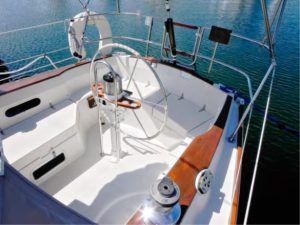
The cockpit is efficient, with two laza¬rettes behind the 40-inch wheel, engine controls under the starboard hatch, and ready access to the rudder stock for a short emergency tiller.
Starting at the bow, we find a very sturdy stemhead fitting that also serves as an anchor roller. It accommodates two anchors offset from one another. Aft of that is a deep anchor locker. Bow to stern are double lifelines between stainless steel pulpits.
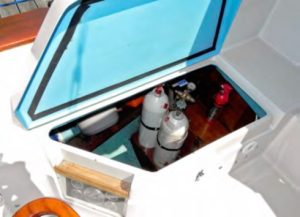
Seventh Heaven has a CNG stove/oven, and because this gas is lighter than air (unlike LPG), its storage compartment does not require a drain, although it does require a vent above the tanks to evacuate any leaking gas. Here the bottles are located in the port seat locker. Some owners have switched to LPG because it is much easier to obtain.
The Sabre 38 has a long, classic cabin trunk. On top are four opening hatches and four Dorade vents with an option to add two more. At the sides of the cabin trunk are four opening ports and two fixed windows per side. Long teak handholds provide security going forward. Genoa tracks are mounted on the toerail and inboard on the cabin trunk.
Moving aft, a generous T-shaped cockpit is protected by a dodger (with Makrilon glass) and a bimini with solar panels on top. Leading to the cabin is a short passage over a bridge deck with a wide companionway protected by a sea hood.
An optional swim ladder comes up to the stern pulpit and serves as a gate. I discussed with Dave my desire that swim ladders could be deployed from the water by a person caught overboard. For this, he had a long, easily usable line reachable from the water. The reverse transom has no scoop to serve as dinghy boarding or swim platform; this boat was designed before that trend came along, but a platform could be added.
The cockpit seats are wide but a tad short for stretched-out napping, thus earning a Penticoff Napability Index rating (scale of 1-5) of 3. However, should one remove the wheel, which is easily accomplished, and fabricate small inserts, the PNI would rise to 5. The stern seat is nearly wide and long enough for a good nap, too.
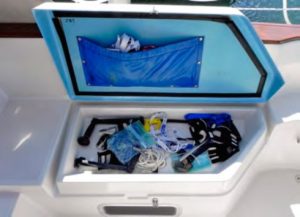
Because of the quarter berth below, the starboard seat locker is quite shallow.
The cockpit coaming edge is relieved with a chamfer, making for a gentle seatback with storage in cubbies below, but the seats are a bit far apart for comfortable bracing while heeled. There is a manual bilge pump readily at hand in the cockpit as well as a pressurized swim showerhead and the crank for the centerboard hoist.
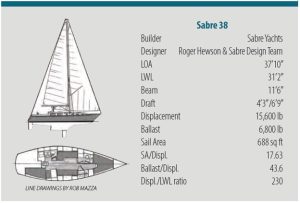
Rig
The Sabre 38 has a tall, high-aspect-ratio rig. The mast is supported by double spreaders and double shrouds as well as double inner lower shrouds—all mounted inboard. The headsail is a 135 percent genoa on a roller furler. The mainsail is a North 3DL with two full battens and three partial battens guided up and down by a Dutchman flaking system. A hydraulic backstay keeps it all tight.
The halyards lead to winches on the mast, but all other running rigging is led to the cockpit with stop clutches. The headsail sheets lead to big, Lewmar 48 two-speed, self-tailing winches mounted on the cockpit coamings. The mainsheet is mounted mid-boom with a traveler forward of the dodger keeping the bridge deck clear but making for somewhat inconvenient mainsail adjustments if racing or sailing shorthanded.
Interior
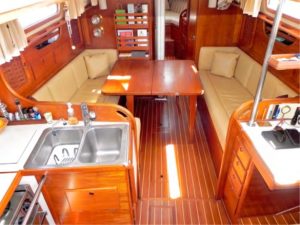
Belowdecks is “teaklandia.” There’s lots of teak, everywhere, but abundant light and bright upholstery counterbalance the dark wood. The port settee converts to a double berth.
Seventh Heaven has the classic interior layout, with quarter berth to starboard; in the alternative aft cabin layout, that area is enclosed, the nav table moved forward, and there’s a quarter berth on the port side aft of the galley. The saloon is the same in each with opposing settees and drop-down table. In the classic layout, the compact galley is tucked into the port quarter area, next to the companionway ladder, and should provide adequate support for cooking underway.
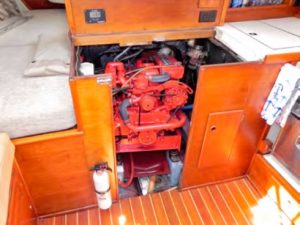
Access to the engine is quite good. The companionway steps move as a unit with the cabinetry. Additional access is good from the portside cockpit locker, and a bit more access is available from the starboard aft berth.
After taking in the beauty of all the teak below, the next thing one notes is all the light and ventilation. Despite the ample wood, the saloon and forward cabin have an open, airy feel, in part because of the Nehrings’ light-colored upholstery.
The saloon table folds down in two sections to create a very large dining/working surface. It should be folded up while underway so that anyone moving about can reach a grabrail below the saloon windows. Thoughtful handholds are also located at the ends of the galley, nav station, and top of the ladder. The insides of all lockers and storage areas are very well finished with no rough surfaces apparent.
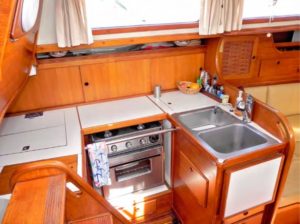
The galley holds a double sink, three-burner CNG stove, and DC-powered Frigoboat refrigerator. The four-step ladder has storage under three of them.
The centerboard cable is in the bilge, down with the accessible keel bolts. Dave fabricated a collar/pan for the mast at the mast step that drains rainwater via a hose to the bilge sump. He and other owners caution buyers to look for rot in the sole near the mast step due to this problem of rainwater following the mast slot to the bottom. The cabin overhead is vinyl fabric joined with varnished teak battens.
There are two doors to the head so that privacy can be maintained for those residing on either side of this door while others use the facilities. The V-berth is roomy and airy, and a thoughtful wood step is mounted on the bulkhead if you wish to pop right out the hatch overhead. Dave reports that Sharon often leaves the cabin this way, as do their grandchildren.
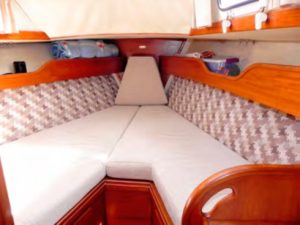
The spacious V-berth has the usual insert to convert two singles to a double.
The water heater and three batteries reside under the quarter berth. During cooler weather a diesel cabin heater warms the interior.
Underway
Our test sail took place on Wisconsin’s lovely Sturgeon Bay, near Green Bay where there is plenty of room. The Sabre 38 tracked very well when on the wind (12-15 knots apparent) but seemed to need a bit more attention to steering it straight when off the wind. In tacks to windward it came about very quickly. The deep-draft fin keel version is likely even quicker.
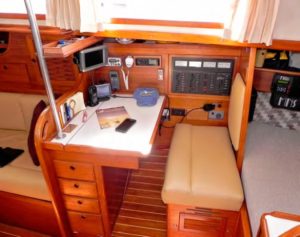
Opposite the galley is the somewhat tight nav station tucked under the sidedeck. Very long drawers slide out of the nav station cabinetry.
One can sit and steer the big wheel from many spots or stand quite comfortably. Dave suggested I try stretching out on the stern seat to steer, back to leeward. It was fine; I’d call this the “Barcalounger position.” There was no sense of weather helm to fight, just a touch of it (as it should be), and we could easily point to 35 degrees apparent. The feel was neither heavy nor fingertip light.
In terms of PHRF rating, most of the boats rate 132 seconds per mile, the same as a Catalina 38 centerboard and a shoal-draft Beneteau 38.
As mentioned earlier, the offset prop shaft makes for “non-standard” use of prop and rudder while maneuvering in close quarters. However, one owner says it can be used to one’s advantage, and on returning to the marina Dave demonstrated an easily made tight U-turn into the slip.
Conclusion
Many sailing yachts in this size range are limited production. With 100 of the Sabre 38s built and 114 of the Mk II models, this is a good run. There were several of both listed on internet sales sites. Online prices ran from $50,000 for a 1983 to $75,000 for a 1986, with two 1985 listings at $65,000. The Mk IIs run quite a bit more. These boats hold a lot of appeal for the cruising sailor, having great sailing characteristics, comfort, and quality traditional construction, yet still equipped to modern standards.
Good Old Boat Contributing Editor Allen Penticoff is a freelance writer, sailor, and longtime aviator. He has trailer-sailed on every Great Lake and on many inland waters and has had keelboat adventures on fresh and saltwater. He owns an American 14.5, a MacGregor 26D, and a 1955 Beister 42-foot steel cutter that he stores as a “someday project.”
Thank you to Sailrite Enterprises, Inc., for providing free access to back issues of Good Old Boat through intellectual property rights. Sailrite.com

